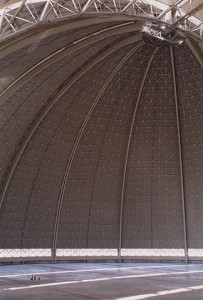During the late ’90s and early 2000s, there was an unlikely technological revival: airships.
The Hindenburg disaster sunk commercial airships for most of the twentieth century, leaving pretty much only the Goodyear blimps.
During the great economy of the ’90s, investors lined up to toss money at anything that popped up its head, which ended up turning out pretty badly for many of them. There were several airship startups among them.
Cargolifter AG, which opened its doors in ’96 was a German company with a plan to build truly colossal airship freight lifters. The initial plan was to build one with a 160 ton lifting capacity, but there was talk of constructing airships several times that large. The company spent a nutty amount of money constructing a hangar, called the Aerium, for the airships at an old airfield. The Aerium is, to this day, the fourth largest building in the world. You could fit an aircraft carrier inside with room to spare. (I don’t know why you’d want to, though).
Before Cargolifter AG couldn’t get anything other than a small test balloon built, though; they ran out of money and had to fold in 2002. The building was sold to a resort company, who turned it into a gargantuan indoor tropical park, featuring a swimming pool the size of a lake with waves and beaches, miles of jungle paths, spas, and so on and so forth. (Now there’s somewhere I can convince Maggie to go).
The Ukrainian company Aeros is a slightly more cheerful story. They already had a line of products to keep them in business, manufacturing hang-gliders and other ultra light craft. They’re sinking their budget into R&D for the Aeroscraft, a huge, sleek, rigid airship that looks like something out of Star Wars. It’s not a strictly lighter-than-air vehicle, and it also features huge vertical thrusters. They actually flew their prototype this year, after a decade of development.
Maggie and I love hot air balloons, so here’s keeping my fingers crossed we’ll get to start taking commercial airship flights soon enough.
